+ Open data
Open data
- Basic information
Basic information
| Entry | Database: PDB / ID: 5vf3 | ||||||||||||
|---|---|---|---|---|---|---|---|---|---|---|---|---|---|
| Title | Bacteriophage T4 isometric capsid | ||||||||||||
 Components Components |
| ||||||||||||
 Keywords Keywords | VIRUS / Bacteriophage T4 / isometric head / virus capsid assembly / triangulation numbers / size-determining mutations / capsid stabilization / capsid decoration proteins | ||||||||||||
| Function / homology |  Function and homology information Function and homology information | ||||||||||||
| Biological species |  Enterobacteria phage T4 (virus) Enterobacteria phage T4 (virus) | ||||||||||||
| Method | ELECTRON MICROSCOPY / single particle reconstruction / cryo EM / Resolution: 3.3 Å | ||||||||||||
 Authors Authors | Chen, Z. / Sun, L. / Zhang, Z. / Fokine, A. / Padilla-Sanchez, V. / Hanein, D. / Jiang, W. / Rossmann, M.G. / Rao, V.B. | ||||||||||||
| Funding support |  United States, 3items United States, 3items
| ||||||||||||
 Citation Citation |  Journal: Proc Natl Acad Sci U S A / Year: 2017 Journal: Proc Natl Acad Sci U S A / Year: 2017Title: Cryo-EM structure of the bacteriophage T4 isometric head at 3.3-Å resolution and its relevance to the assembly of icosahedral viruses. Authors: Zhenguo Chen / Lei Sun / Zhihong Zhang / Andrei Fokine / Victor Padilla-Sanchez / Dorit Hanein / Wen Jiang / Michael G Rossmann / Venigalla B Rao /  Abstract: The 3.3-Å cryo-EM structure of the 860-Å-diameter isometric mutant bacteriophage T4 capsid has been determined. WT T4 has a prolate capsid characterized by triangulation numbers (T numbers) T = 13 ...The 3.3-Å cryo-EM structure of the 860-Å-diameter isometric mutant bacteriophage T4 capsid has been determined. WT T4 has a prolate capsid characterized by triangulation numbers (T numbers) T = 13 for end caps and T = 20 for midsection. A mutation in the major capsid protein, gp23, produced T=13 icosahedral capsids. The capsid is stabilized by 660 copies of the outer capsid protein, Soc, which clamp adjacent gp23 hexamers. The occupancies of Soc molecules are proportional to the size of the angle between the planes of adjacent hexameric capsomers. The angle between adjacent hexameric capsomers is greatest around the fivefold vertices, where there is the largest deviation from a planar hexagonal array. Thus, the Soc molecules reinforce the structure where there is the greatest strain in the gp23 hexagonal lattice. Mutations that change the angles between adjacent capsomers affect the positions of the pentameric vertices, resulting in different triangulation numbers in bacteriophage T4. The analysis of the T4 mutant head assembly gives guidance to how other icosahedral viruses reproducibly assemble into capsids with a predetermined T number, although the influence of scaffolding proteins is also important. | ||||||||||||
| History |
|
- Structure visualization
Structure visualization
| Movie |
 Movie viewer Movie viewer |
|---|---|
| Structure viewer | Molecule:  Molmil Molmil Jmol/JSmol Jmol/JSmol |
- Downloads & links
Downloads & links
- Download
Download
| PDBx/mmCIF format |  5vf3.cif.gz 5vf3.cif.gz | 1.2 MB | Display |  PDBx/mmCIF format PDBx/mmCIF format |
|---|---|---|---|---|
| PDB format |  pdb5vf3.ent.gz pdb5vf3.ent.gz | 1 MB | Display |  PDB format PDB format |
| PDBx/mmJSON format |  5vf3.json.gz 5vf3.json.gz | Tree view |  PDBx/mmJSON format PDBx/mmJSON format | |
| Others |  Other downloads Other downloads |
-Validation report
| Summary document |  5vf3_validation.pdf.gz 5vf3_validation.pdf.gz | 1.2 MB | Display |  wwPDB validaton report wwPDB validaton report |
|---|---|---|---|---|
| Full document |  5vf3_full_validation.pdf.gz 5vf3_full_validation.pdf.gz | 1.3 MB | Display | |
| Data in XML |  5vf3_validation.xml.gz 5vf3_validation.xml.gz | 192.5 KB | Display | |
| Data in CIF |  5vf3_validation.cif.gz 5vf3_validation.cif.gz | 286.9 KB | Display | |
| Arichive directory |  https://data.pdbj.org/pub/pdb/validation_reports/vf/5vf3 https://data.pdbj.org/pub/pdb/validation_reports/vf/5vf3 ftp://data.pdbj.org/pub/pdb/validation_reports/vf/5vf3 ftp://data.pdbj.org/pub/pdb/validation_reports/vf/5vf3 | HTTPS FTP |
-Related structure data
| Related structure data |  8661MC M: map data used to model this data C: citing same article ( |
|---|---|
| Similar structure data |
- Links
Links
- Assembly
Assembly
| Deposited unit | 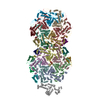
|
|---|---|
| 1 | x 60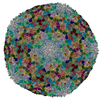
|
| 2 |
|
| 3 | x 5
|
| 4 | x 6
|
| 5 | 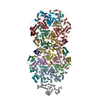
|
| Symmetry | Point symmetry: (Schoenflies symbol: I (icosahedral)) |
- Components
Components
| #1: Protein | Mass: 45838.574 Da / Num. of mol.: 1 / Source method: isolated from a natural source / Source: (natural)  Enterobacteria phage T4 (virus) / References: UniProt: P19896 Enterobacteria phage T4 (virus) / References: UniProt: P19896 | ||||||
|---|---|---|---|---|---|---|---|
| #2: Protein | Mass: 48728.863 Da / Num. of mol.: 12 / Source method: isolated from a natural source / Source: (natural)  Enterobacteria phage T4 (virus) / References: UniProt: P04535 Enterobacteria phage T4 (virus) / References: UniProt: P04535#3: Protein | Mass: 9085.095 Da / Num. of mol.: 11 / Source method: isolated from a natural source / Source: (natural)  Enterobacteria phage T4 (virus) / References: UniProt: P03715 Enterobacteria phage T4 (virus) / References: UniProt: P03715#4: Protein | | Mass: 40416.547 Da / Num. of mol.: 1 / Source method: isolated from a natural source / Source: (natural)  Enterobacteria phage T4 (virus) / References: UniProt: P18056 Enterobacteria phage T4 (virus) / References: UniProt: P18056#5: Protein/peptide | | Mass: 1294.587 Da / Num. of mol.: 1 / Fragment: unidentified segment / Source method: isolated from a natural source / Source: (natural)  Enterobacteria phage T4 (virus) Enterobacteria phage T4 (virus) |
-Experimental details
-Experiment
| Experiment | Method: ELECTRON MICROSCOPY |
|---|---|
| EM experiment | Aggregation state: 2D ARRAY / 3D reconstruction method: single particle reconstruction |
- Sample preparation
Sample preparation
| Component | Name: Enterobacteria phage T4 / Type: VIRUS / Entity ID: all / Source: NATURAL |
|---|---|
| Source (natural) | Organism:  Enterobacteria phage T4 (virus) Enterobacteria phage T4 (virus) |
| Details of virus | Empty: YES / Enveloped: NO / Isolate: SPECIES / Type: VIRION |
| Natural host | Organism: Escherichia coli |
| Virus shell | Name: gp23*-gp24*-Soc-Hoc / Diameter: 860 nm / Triangulation number (T number): 13 |
| Buffer solution | pH: 7 Details: 50 mM sodium phosphate, pH 7.0, 75 mM sodium chloride, 1 mM magnesium chloride |
| Specimen | Conc.: 1 mg/ml / Embedding applied: NO / Shadowing applied: NO / Staining applied: NO / Vitrification applied: YES Details: High-purity sample, volume = 50 uL, 10^12 particles |
| Specimen support | Details: glow discharge for 60 seconds with 30 mA current / Grid material: COPPER / Grid mesh size: 400 divisions/in. / Grid type: Ted Pella |
| Vitrification | Instrument: GATAN CRYOPLUNGE 3 / Cryogen name: ETHANE / Humidity: 80 % / Chamber temperature: 298 K / Details: Blot for 8 seconds before plunging. |
- Electron microscopy imaging
Electron microscopy imaging
| Experimental equipment |  Model: Titan Krios / Image courtesy: FEI Company |
|---|---|
| Microscopy | Model: FEI TITAN KRIOS / Details: Data collection by Leginon |
| Electron gun | Electron source:  FIELD EMISSION GUN / Accelerating voltage: 300 kV / Illumination mode: FLOOD BEAM FIELD EMISSION GUN / Accelerating voltage: 300 kV / Illumination mode: FLOOD BEAM |
| Electron lens | Mode: BRIGHT FIELD / Nominal magnification: 18000 X / Calibrated magnification: 18000 X / Nominal defocus max: -3000 nm / Nominal defocus min: -1000 nm / Calibrated defocus min: -800 nm / Calibrated defocus max: -3500 nm / Cs: 2.7 mm / C2 aperture diameter: 70 µm / Alignment procedure: COMA FREE |
| Specimen holder | Cryogen: NITROGEN / Specimen holder model: OTHER / Temperature (max): 100 K / Temperature (min): 90 K / Residual tilt: 0.5 mradians |
| Image recording | Average exposure time: 9 sec. / Electron dose: 26 e/Å2 / Detector mode: SUPER-RESOLUTION / Film or detector model: GATAN K2 SUMMIT (4k x 4k) / Num. of grids imaged: 1 / Num. of real images: 3000 Details: Images were collected in super-resolution mode at 40 frames per second. |
| Image scans | Sampling size: 2 µm / Width: 3710 / Height: 3838 / Movie frames/image: 75 / Used frames/image: 3-22 |
- Processing
Processing
| EM software |
| |||||||||||||||
|---|---|---|---|---|---|---|---|---|---|---|---|---|---|---|---|---|
| Image processing | Details: The selected images were gain-normalized. | |||||||||||||||
| CTF correction | Details: CTF amplitude correction was performed during 3D reconstruction. Type: PHASE FLIPPING ONLY | |||||||||||||||
| Particle selection | Num. of particles selected: 19000 Details: Approximately 1000 manually-picked particles were used for 2D classification. Templates were then generated from these 2D classes and used for automated particle picking. | |||||||||||||||
| Symmetry | Point symmetry: I (icosahedral) | |||||||||||||||
| 3D reconstruction | Resolution: 3.3 Å / Resolution method: FSC 0.143 CUT-OFF / Num. of particles: 18000 / Algorithm: FOURIER SPACE Details: Independent refinement of even/odd map, gold standard Num. of class averages: 60 / Symmetry type: POINT | |||||||||||||||
| Atomic model building | Protocol: AB INITIO MODEL / Space: REAL |
 Movie
Movie Controller
Controller



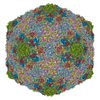
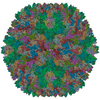
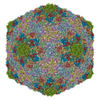







 PDBj
PDBj
